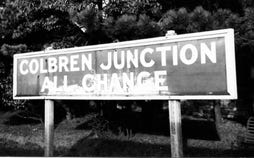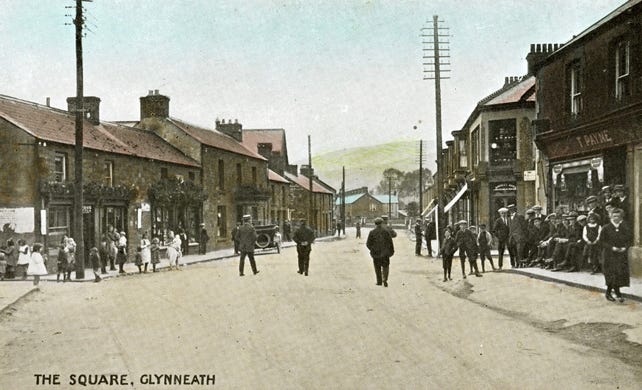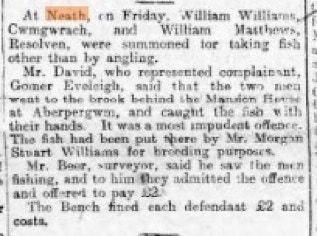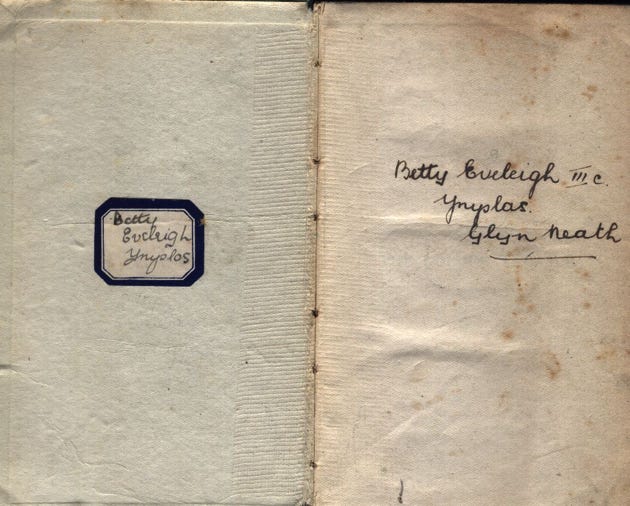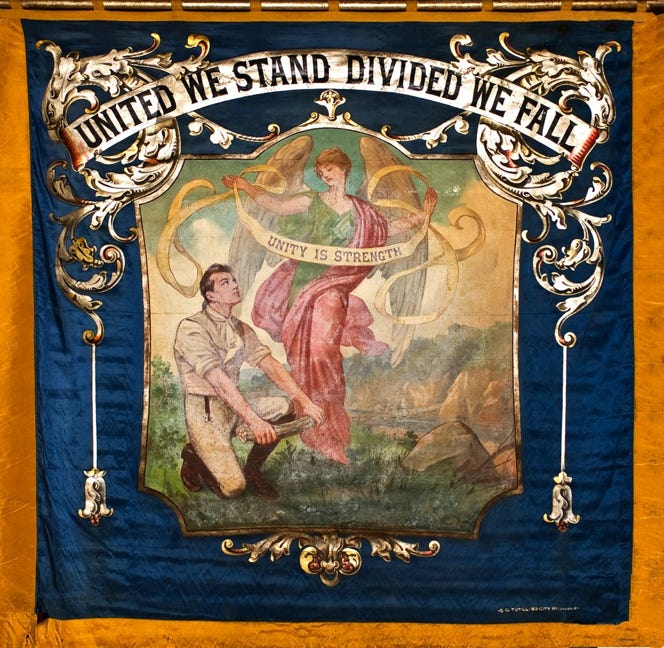Margaret Jones was Richard and Ann Jones’ third child and in 1861, she is shown aged 28, unmarried at home with her parents on the Banwen moor at Maesmarchog.
In 1865, she married Robert Eveleigh, a miner originally of Woodbury, Devon. The couple had four children between 1867 and 1874. In 1881, the family is shown altogether at Bethania Street, Glynneath, which is where Robert and Margaret appear to have lived since marriage. This street was central to the village and entirely rudimentary in its construction of small two up-two down style terraced cottages.
By 1891, the only children still at home are Gomer, 24, who is showing promise away from the mines as an accountant, and Margaret Ann, 16. By 1901, only Robert and Margaret remain at 6 Bethania Street.
Robert died on 6 January 1902. Probate of his will was granted to his son Gomer and his effects were valued at £454. This was a tidy figure for 1902, if one considers that three bedroom terraced houses were being sold around the country for between £200 and £300, depending on area (source: Guardian 18/12/1999).
So by the time of the 1911 census, Margaret is recorded a widow, and has moved to number 22 Bethania Street. She has two lodgers and also there on census night is Eleanor Rees, 13, granddaughter; perhaps she is permanently resident to make space in her own family’s house although we will see later that is not the case here.
Margaret Eveleigh died shortly later in the third quarter of 1911, aged 78.
Children of Margaret Jones & Robert Eveleigh
1.Gomer Eveleigh 1867-1943
Gomer Eveleigh, appears to have been a manager and/or accountant on the Aberpergym Estate. The young and ambitious Gomer started work as a collier but after marrying Mary Ann Thomas in 1896, the family moved quickly to Cwmgwrach, a village very close to both Glynneath and the Aberpergwm estate and colliery to its west.
As an accountant for the estate collieries, Gomer was able to move up in the world somewhat, away from the cramped terraces of his birth at Glynneath and by 1921, Gomer describes himself as an Estate Sub-Agent, still at Aberpergwm, and appears proud to dutifuly record his employer personally as Herbert H. Williams. The latter’s family had held the Aberpergwm Estate for centuries and were now making a fortune from the coal underneath their seat and estate lands.
There had also been another house move for Gomer and family- now they are living at Ynyslas, Cwmgwrach, without doubt representing more advancement in the family’s status. A servant, 25 year old Mary Thomas, is employed.
Gomer died aged 76 at Porthcawl, to where he seems to have retired with Margaret. They lived in South Place, a road of comfortable and typical inter-war semi-detached villas. Widow Margaret and daughter Gwladys were granted probate of the estate whose effects were valued at the then substantial sum of £8140 5s. 8d.
Children of Gomer & Mary Ann Eveleigh:
Gwaldys Eveleigh 1900- a domestic science teacher in 1921, at the council school Glynnneath, unmarried and living at home. She married Evan James in 1925 at Neath. The couple later lived in Bowen Street, Neath.
Betty Eveleigh 1904- aged 17 in 1921, recorded as ‘Home duties’.
_________________________________________________________________
2. Mary Ellen Eveleigh 1868-1942
Mary married Thomas Thorburn (1867-), a collier, of Carmarthenshire in 1889. The couple started married life next door to Mary’s parents Bethania Street, Glynneath (numbers 7 and 8).
By 1911 father Thomas has become a foreman in a brickworks and the family has perhaps in consequence moved out of the cramped conditions of Bethania Street to a 8-room house at Abernant Terrace . The streets around here were slum-cleared later and the names went with them. Four children are still at home with eldest David shown as a (stationary) colliery engineman, hence a surface worker.
The Abernant Dinas Silica Brick & Coal Company was founded in 1843 and
produced bricks that could withstand very high temperatures, used to
line copper and iron furnaces. The Dinas silica mine was nearby at Pontneddfechan, east of Glynneath. Horse-drawn tramways would transport the raw and finished materials, the latter being eventually transferred to barges on the Neath Canal for transport westward to the smelting centres of Neath and Swansea.
As a widow in 1939, Mary is shown perhaps with a couple of lodgers (called Griffiths) at 22 Bethania Street, Glynneath.
Thomas Thorburn died in 1930 and Mary Eleanor in 1942.
Children of Mary & Thomas Thorburn:
David Thorburn 1889-1972 married Catherine Richards in 1921 at Neath. In 1939 they are at ‘Isfryn’, Woodland Park, Glynneath. David specialised in operating stationary colliery engines and turbines .
Margaret A Thorburn 1891-
Myfanwy Thorburn 1893-
Gomer Thorburn 1898-1967 married Bessie Davies in 1921 at Neath. There is no trace of this couple in the 1921 census, but by 1939 they are shown at 13 Oddfellows Street, Glynneath. A child, Alexander Thorburn (1921-2003), is with them.
Edna Maud Thorburn 1906- married Thomas Griffiths in 1927 at Neath
_________________________________________________________________
3. John Eveleigh 1873-1890 aged 17, cause of death unknown
_________________________________________________________________
4. Elizabeth Ann Eveleigh 1876-1904 married Morgan Evan Rees at Neath in 1894. By 1901, their young family already included four children, all daughters so far. They lived at 4 Oddfellows Row, Glynneath, next door neighbours of Elizabeth’s uncle at number 5, Jacob Jones.
Tragically, Elizabeth Ann died in 1904, aged only 29. In 1911, Morgan and youngest daughter Ceinwen, now aged 10, are boarders at the Old White Hart, Glynneath, head of household Thomas Jones. Both men are Colliery Overmen. Eldest daughter Morfydd is with the Edwards, her aunt and uncle. Daughter Eleanor is with her grandmother, Margaret Eveleigh at 22 Bethania Street while Mary is with another grandmother, Catherine Rees at 12 Oddfellows Street.
Thus did the extended family rally round to help widowed Morgan bring up his four daughters.
Children of Elizabeth Ann Eveleigh & Morgan Rees
Morfydd Rees 1897-
Eleanor Rees 1898-
Mary Rees 1900-
Ceinwen Rees 1901-
_________________________________________________________________
Why is a Glynneath street and pub named Oddfellows?
Before National Insurance, private insurance or the Welfare State, families had only themselves to rely on in times of hardship. Accidents at work, premature death to disease, loss of earnings due to strikes and lockouts could very quickly create highly adverse circumstances.
The Independent Order of Oddfellows derived from an originally American organisation and was one example of a friendly society set up with the sole purpose of allowing mutual help and support between its working class members.
Trade guilds of medieval origin had a role in providing benevolence to members falling on hard times, but this was limited to a small section of the population, usually in large towns.] and specific to occupation. The Oddfellows chose that name because they did not associate with a particular trade or industry.
From the middle of the seventeenth century, friendly societies grew up in all industrial areas. Exact models varied but generally members paid small weekly contributions to be guaranteed some form of financial and medical support in times of need. Funeral expenses were often covered.
The government, employers and the established clergy actively discouraged any form of combination or association between workers. The authorities’ aim was to divide and rule and the friendly societies seemed to threaten this.
Those in charge were further extremely wary of what they saw as secret cabals: with their initiation rites, passwords and secret communication methods, the clubs appeared to promise only revolution and insurrection. The societies were at first deemed illegal and thus went further underground. Paid government informers were rife. In “This Proud and Savage Land”, Alexander Cordell vividly captures the febrile industrial atmosphere in South Wales at the beginning of the nineteenth century and ably documents these nascent and clandestine workers’ organisations.
Certainly to begin with, the societies were exclusively masculine and often met in pubs (the ‘top room’ or cellar were favoured locations) and men clearly enjoyed the fellowship away from both work and their wives.
Still, today, we have the Oddfellows, the Foresters, the Ivorites, Buffs and the Elks. Some of these developed more into what are described as fraternal orders, and in so doing approached the pseudo-religiosity and ritualism of freemasonry; others remained less ceremonial and concentrated purely of the pragmatic task of assisting needy members.
Some friendly societies provided the basis for trade unions; others have developed into modern financial services organisations, still offering savings and insurance. Regrettably for some, they have no banners and don’t do dressing up.
